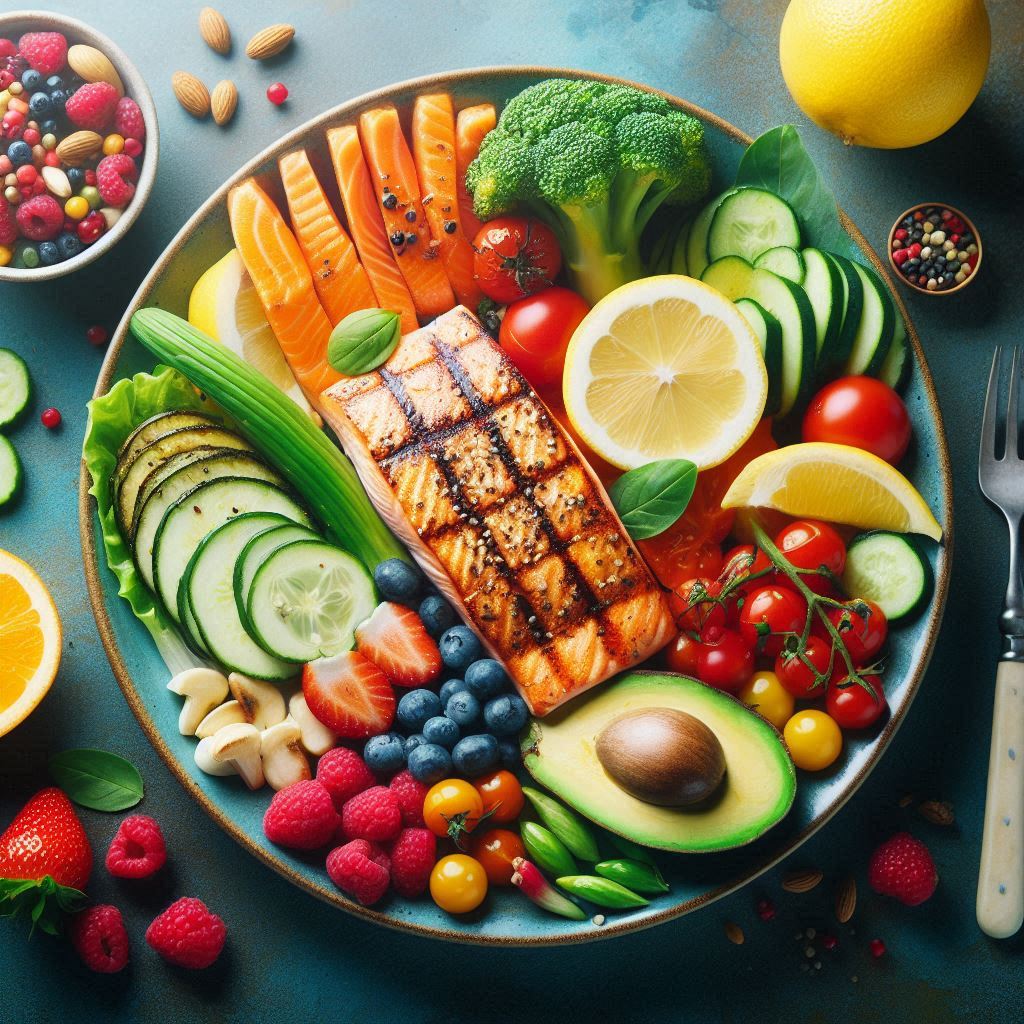A) Healthy Weight-Losing Diets: A Guide to Sustainable Weight Management
Shedding pounds can be a challenging feat, but prioritizing healthy weight-loss strategies is crucial for lasting success. This article explores some of the most recommended diets for achieving your weight loss goals while promoting overall well-being.
Understanding the Fundamentals of a Healthy Weight Loss Journey
According to Harvard Health Publishing, a healthy approach to weight loss focuses on gradual, sustainable changes [1]. Aiming for a weight loss of 1-2 pounds per week allows for consistent progress while minimizing the risk of nutrient deficiencies or muscle loss [1].
Exploring Nutritious Diet Plans
Numerous healthy weight-loss diets can provide a structured approach to achieving your goals. Here’s a closer look at some popular options:
The Mediterranean Diet: A Heart-Healthy Approach to Weight Management

The Mediterranean diet, inspired by the traditional eating patterns of countries bordering the Mediterranean Sea, emphasizes fruits, vegetables, whole grains, legumes, nuts, and olive oil. Moderate consumption of fish and poultry complements this plant-based foundation [2]. This diet is renowned for its numerous health benefits, including weight loss, improved heart health, and a reduced risk of chronic diseases like type 2 diabetes [2]. Studies have shown that the Mediterranean diet’s focus on healthy fats and unprocessed foods promotes satiety and discourages overeating [2].
The DASH Diet: Tailoring Nutrition to Fight Hypertension and Shed Pounds
The DASH (Dietary Approaches to Stop Hypertension) diet, originally designed to combat high blood pressure, also offers significant weight loss benefits [3]. This plan prioritizes fruits, vegetables, whole grains, and lean proteins while limiting added sugars, unhealthy fats, and sodium intake [3]. By emphasizing nutrient-dense, low-calorie foods, the DASH diet promotes feelings of fullness and helps regulate blood pressure, contributing to a healthy weight loss journey [3].
Adopting the Mayo Clinic Diet: Structured Phases for Sustainable Weight Loss
The Mayo Clinic Diet offers a structured approach to weight loss, divided into two distinct phases [2]. The initial phase, “Lose It!”, focuses on establishing healthy eating habits and quick weight loss through portion control and low-calorie meal plans [2]. The subsequent phase, “Live It!”, emphasizes long-term lifestyle changes by encouraging balanced meals, mindful eating practices, and regular physical activity [2]. This two-pronged approach equips individuals with the tools to achieve and maintain a healthy weight.
Integrating the Weight Watchers (WW) Program: Flexibility in Achieving Weight Goals
Weight Watchers (WW) provides a flexible points-based system for weight management. Foods are assigned points based on their calorie content, saturated and unsaturated fat, sugar, and protein levels [4]. Members track their daily food intake and strive to stay within a personalized points budget [4]. WW also offers valuable support through meetings, online tools, and a community forum, fostering accountability and motivation throughout the weight loss journey [4].
Discovering the Volumetrics Diet: Feeling Full on Fewer Calories
The Volumetrics Diet centers around the concept of consuming low-calorie, high-volume foods that promote satiety [5]. This diet encourages filling your plate with fruits, vegetables, soups, and broth-based salads, which are naturally low in calories and high in water content [5]. By prioritizing these nutrient-rich foods, the Volumetrics Diet helps manage hunger cues and supports steady weight loss without feeling deprived [5].
Incorporating Physical Activity for Balanced Weight Loss
While a healthy diet plays a vital role in weight loss, incorporating regular physical activity is equally important. Aim for at least 150 minutes of moderate-intensity exercise or 75 minutes of vigorous-intensity exercise per week [1]. Physical activity helps burn calories, build muscle mass, and improve overall fitness, enhancing your weight loss efforts.
The Importance of Consulting Healthcare Providers Before Major Dietary Changes
Before embarking on a new diet plan, it’s crucial to consult with your healthcare provider. They can assess your individual health needs, identify potential risks or interactions with your medications, and recommend a diet plan that aligns with your overall health goals.
Leveraging Support Systems and Communities for Long-Term Success

Surrounding yourself with a supportive network can significantly impact your weight loss journey. This could include family members, and friends, or joining a weight loss support group. Additionally, many diet programs like Weight Watchers offer online communities and in-person meetings that provide encouragement and accountability to help you stay on track.
Ensuring Mental and Emotional Well-being During the Weight Loss Process
Focusing on mental and emotional well-being is essential during weight loss. Stress, anxiety, and emotional eating can derail your progress. Techniques like mindfulness meditation, yoga, or simply taking time to relax can help manage stress and promote a positive mindset, contributing to long-term success.
References
- Harvard Health Publishing: Diet and Weight Loss. Accessed at: https://www.health.harvard.edu/topics/diet-and-weight-loss/all
- Mayo Clinic: The Mayo Clinic Diet. Accessed at: https://diet.mayoclinic.org/
- U.S. News & World Report: Best Weight-Loss Diets. Accessed at: https://health.usnews.com/best-diet
- Weight Watchers International, Inc. https://www.weightwatchers.com/us/
- Barbara Rolls, Volumetrics Eating Plan https://www.webmd.com/diet/a-z/volumetrics-what-it-is
B) Quick Weight Lose Diet

Achieving quick weight loss requires a strategic approach that prioritizes both efficacy and health. Among the top quick weight loss diets, the Mediterranean and DASH diets stand out for their effectiveness and nutritional balance. The Mediterranean diet, which is rich in healthy fats, lean proteins, and whole grains, supports rapid weight loss by encouraging the consumption of nutrient-dense foods that keep you full longer and prevent overeating. Similarly, the DASH diet, designed initially to combat high blood pressure, promotes the intake of low-calorie, high-nutrient foods like fruits and vegetables, helping you shed pounds quickly while maintaining essential nutrient intake. These diets not only help in losing weight rapidly but also ensure long-term health benefits, making them sustainable and effective options for quick weight loss.
Another effective strategy for quick weight loss is the Volumetrics diet, which focuses on consuming high-volume, low-calorie foods. This approach allows you to eat larger portions while reducing overall calorie intake, helping you feel full and satisfied while losing weight quickly. Foods such as fruits, vegetables, and broth-based soups are staples in this diet, providing essential nutrients and promoting satiety. Additionally, the Mayo Clinic Diet’s “Lose It!” phase is specifically designed to kickstart weight loss with rapid results by encouraging healthy eating habits and regular physical activity. By incorporating these high-ranking, quick weight-loss diets into your routine, you can achieve significant weight loss in a healthy, sustainable manner.
References
1. Harvard Health Publishing: Diet and Weight Loss. Accessed at: https://www.health.harvard.edu/topics/diet-and-weight-loss
2. Mayo Clinic: The Mayo Clinic Diet. Accessed at: https://www.mayoclinic.org/healthy-lifestyle/weight-loss/in-depth/mayo-clinic-diet/art-20045460
3. U.S. News & World Report: Best Weight-Loss Diets. Accessed at: https://health.usnews.com/best-diet/best-weight-loss-diets
C) Running Weight Loss Plan
Incorporating running into a weight loss plan can be an effective and enjoyable way to shed pounds and improve overall health. A running weight loss plan not only helps burn calories but also boosts cardiovascular fitness builds muscle, and enhances mental well-being. Here’s how to create an effective running weight loss plan:
Benefits of Running for Weight Loss
– **Calorie Burn**: Running is a high-intensity exercise that can burn a significant number of calories in a short amount of time. The number of calories burned depends on factors like speed, duration, and individual weight.
– **Increased Metabolism**: Running helps boost metabolism, which can lead to more calories burned throughout the day, even at rest.
– **Improved Cardiovascular Health**: Regular running strengthens the heart, improves circulation, and lowers the risk of cardiovascular diseases.
– **Muscle Building**: Running, especially when combined with interval training and hill sprints, can help build lean muscle mass, increasing resting metabolic rate.
– **Mental Health Benefits**: Running reduces stress, anxiety, and depression, contributing to overall well-being and a more positive mindset toward weight loss.
Creating a Running Weight Loss Plan

1. **Set Realistic Goals**: Start with achievable goals that gradually increase in intensity and duration. Setting realistic milestones can help maintain motivation and track progress.
2. **Mix Up Your Routine**: Incorporate different types of running workouts to keep things interesting and maximize benefits:
– **Steady-State Runs**: Maintain a consistent pace for a set period or distance.
– **Interval Training**: Alternate between high-intensity sprints and lower-intensity recovery periods.
– **Hill Repeats**: Run uphill to build strength and endurance.
– **Long Runs**: Increase stamina and endurance with longer, slower-paced runs once a week.
3. **Combine with Strength Training**: Adding strength training exercises, such as squats, lunges, and core workouts, can enhance muscle tone and support weight loss efforts.
4. **Follow a Balanced Diet**: Nutrition plays a crucial role in weight loss. Focus on a diet rich in lean proteins, whole grains, fruits, and vegetables. Stay hydrated and avoid excessive intake of processed foods and sugary drinks.
5. **Track Your Progress**: Use a running app or journal to log your runs, monitor progress, and adjust your plan as needed. Tracking can help identify patterns and areas for improvement.
6. **Listen to Your Body**: Pay attention to signs of overtraining and take rest days to allow your body to recover. Rest is essential for preventing injuries and ensuring long-term success.
Sample Weekly Running Plan for Beginners
– **Monday**: Rest or light activity (e.g., walking or yoga)
– **Tuesday**: 30-minute steady-state run
– **Wednesday**: Interval training (e.g., 5 x 1-minute sprints with 2-minute recovery)
– **Thursday**: Strength training (focus on legs and core)
– **Friday**: 30-minute steady-state run
– **Saturday**: Long run (start with 45 minutes and gradually increase)
– **Sunday**: Rest or light activity
By following a structured running weight loss plan and incorporating healthy eating habits, you can achieve sustainable weight loss and enjoy numerous physical and mental health benefits.
INSTANTLY Rewire Your Mind to Lose Weight & Get Super Healthy
Conclusion
Weight loss is a multifaceted endeavor that requires a holistic approach. By combining a healthy diet with regular physical activity, seeking guidance from healthcare professionals, and prioritizing mental well-being, you can embark on a sustainable weight loss journey that promotes lasting health and well-being.
Remember, the most effective diet is one you can adhere to for the long term. Choose a plan that fits your lifestyle, preferences, and health goals, and don’t hesitate to seek support from healthcare providers, registered dietitians, or weight loss communities.


